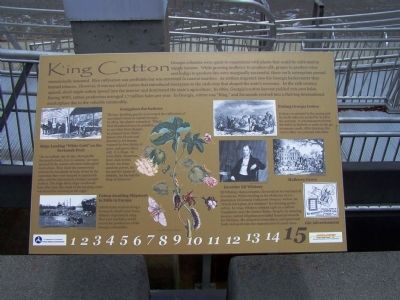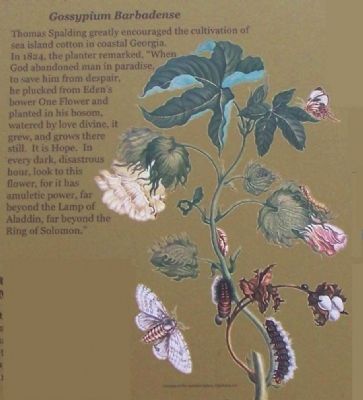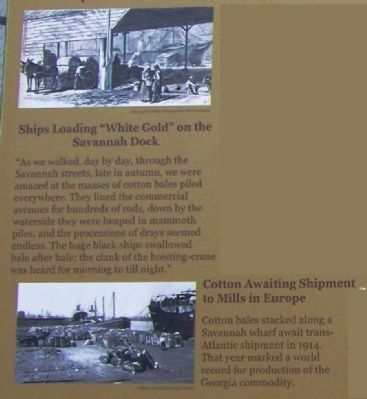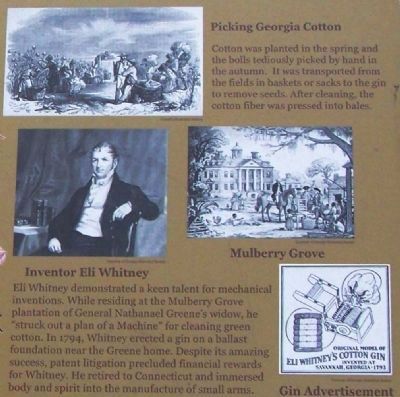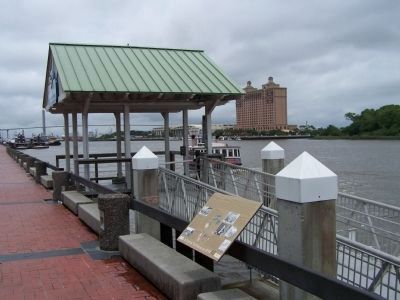Hitch Village/Fred Wessels Homes in Savannah in Chatham County, Georgia — The American South (South Atlantic)
King Cotton
Georgia colonists were quick to experiment with plants that could be cultivated to supply income. While growing mulberry to produce silk, grapes to produce wine and indigo to produce dye were marginally successful, those early enterprises proved economically unsound. Rice cultivation was profitable but was restricted to coastal marshes. As settlers migrated into the Georgia backcountry they farmed tobacco. However, it was sea island cotton that introduced Georgians to the cash crop that shaped the state's economy. In the 19th century upland, short staple cotton spread into the interior and dominated the state's agriculture. In 1860, Georgia's cotton harvest yielded 700,000 bales. During WWI, cotton production averaged 1.7 million bales per year. In Georgia, cotton was "King," and Savannah evolved into a thriving international marketplace due to the valuable commodity.
Gossypium Barbadense
Thomas Spalding greatly encouraged the cultivation of sea island cotton in coastal Georgia. In 1824, the planter remarked,"When God abandoned man in paradise, to save him from despair, he plucked from Eden's bower One Flower and planted in his bosom, watered by love divine, it grew, and grows there still. It is Hope. In every dark, disastrous hour, look to this flower, for it has amuletic power, far beyond the Lamp of Aladdin, far beyond the Ring of Solomom."
Picking Georgia Cotton
Cotton was planted in the spring and the bolls tediously picked by hand in the autumn. It was transported from the fields in baskets or sacks to the gin to remove seeds. After cleaning, the cotton fiber was pressed into bales.
Ships Loading "White Gold" on the Savannah Dock
"As we walked, day by day, through the Savannah streets, late into autumn, we were amazed at the masses of the cotton bales piled everywhere. They lined the commercial avenues for hundreds of rods, down by the waterside they were heaped in mammoth piles, and the processions of drays seemed endless. The huge black ships swallowed bale after bale; the clank of the hoisting-crane was heard for morning to till night."
Cotton Awaiting Shipment to Mills in Europe
Cotton bales stacked along a Savannah wharf await trans-Atlantic shipment in 1914. That year marked a world record production of the Georgia commodity.
Inventor Eli Whitney
Eli Whitney demonstrated a keen talent for mechanical inventions. While residing at the Mulberry Grove plantation of General Nathanael Greene's widow, he "struck out a plan of a Machine" for cleaning green cotton. In 1794, Whitney erected a gin on a ballast foundation near the Greene home. Despite its amazing success, patent litigation precluded financial rewards for Whitney. He retired to Connecticut and immersed body and spirit into the manufacture of small arms.
Erected 2009 by U.S. Dept. Of Transportation Federal Highway Administration, Georgia Dept. of Transportation. (Marker Number 15.)
Topics. This historical marker is listed in these topic lists: Colonial Era • Natural Resources • Settlements & Settlers. A significant historical year for this entry is 1860.
Location. 32° 4.758′ N, 81° 4.907′ W. Marker is in Savannah, Georgia, in Chatham County. It is in Hitch Village/Fred Wessels Homes. Marker is on East River Street. Near East Broad Street. Ramp at the Riverside. Touch for map. Marker is in this post office area: Savannah GA 31401, United States of America. Touch for directions.
Other nearby markers. At least 8 other markers are within walking distance of this marker. Savannah's Liberty Ships and the Atlantic Bridge (within shouting distance of this marker); Savannah's Early Economy (about 400 feet away, measured in a direct line); Native Americans on the Georgia Coast (about 600 feet away); The Trustees' Garden (about 700 feet away); 1996 Olympic Yachting Cauldron (about 700 feet away); Crossing the Savannah (about 700 feet away); New World Medical Plants (approx. 0.2 miles away); The Old Pirates House (approx. 0.2 miles away). Touch for a list and map of all markers in Savannah.
Related marker. Click here for another marker that is related to this marker. study marker for Mulberry Grove
Credits. This page was last revised on February 8, 2023. It was originally submitted on May 25, 2009, by Mike Stroud of Bluffton, South Carolina. This page has been viewed 2,615 times since then and 20 times this year. Photos: 1, 2, 3, 4, 5. submitted on May 25, 2009, by Mike Stroud of Bluffton, South Carolina. • Syd Whittle was the editor who published this page.
